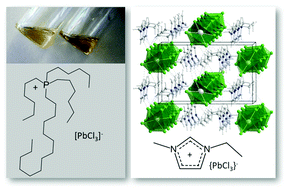Lead(ii) chloride ionic liquids and organic/inorganic hybrid materials – a study of chloroplumbate(ii) speciation†
Abstract
A range of chloroplumbate(II)

* Corresponding authors
a
QUILL, The Queen's University of Belfast, Belfast, UK
E-mail:
m.swadzba-kwasny@qub.ac.uk
A range of chloroplumbate(II)

 Please wait while we load your content...
Something went wrong. Try again?
Please wait while we load your content...
Something went wrong. Try again?
F. Coleman, G. Feng, R. W. Murphy, P. Nockemann, K. R. Seddon and M. Swadźba-Kwaśny, Dalton Trans., 2013, 42, 5025 DOI: 10.1039/C3DT32742F
This article is licensed under a Creative Commons Attribution 3.0 Unported Licence. You can use material from this article in other publications without requesting further permissions from the RSC, provided that the correct acknowledgement is given.
Read more about how to correctly acknowledge RSC content.
 Fetching data from CrossRef.
Fetching data from CrossRef.
This may take some time to load.
Loading related content
